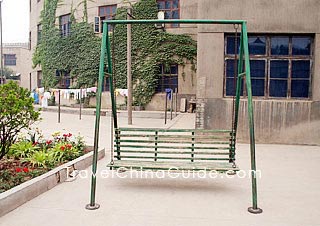Aerial Sports
To Have a Swing (Dang Qiuqian)
 |
| A swing (Qiuqian) |
There is a story about the swing, which goes like this: in the reign of the Emperor Kangxi in the Qing Dynasty (1644 - 1911), the people in a place called Jia Yi suffered from the plague. The villagers built temples to worship the saints and prayed for good health, and soon their wishes were realized. To show their gratitude to the saints, people took great pains to think how to amuse them in addition to the usual annual fetes on each saint's day. One day, a talented scholar saw his little daughter playing cheerily on a swing. This gave him a brainwave and so a swing competition was inaugurated as a wonderful way to pay homage and respect to the deities. From then on, the swing occupied an important place in the sporting activities.
The Korean and Bai ethnic groups are particularly expert in these swing activities. During the festivals they wear their fineries and decorate the swings to be as beautiful as possible. The thick ropes are tied on horizontal branches of large trees, bold and uninhibited people will then hang a ribbon or a ring above and before the swing so that players have to swing up to reach them. The high flying, graceful and daring performers are greeted by the cheers and applause of the enthusiastic onlookers.
See-Saw Jump (Tiaoban)
This is jumping with a spring board. The contests are popular with the women of the Korean ethnic group and are usually held during the Lantern Festival, Dragon Boat Festival and on Mid-Autumn Day. Legend has it that, in ancient times, two innocent men were arrested and put into prison. Their wives who were keen to see their husbands had a bright idea. They would use a spring board to throw themselves into sky, so that they could look down and see their husbands. Another story concerns constraints placed upon women by the yoke of feudal society. At that time women were unable to step out from their courtyards. So, to see something of the outside world they would silently jump high into the air with springboards and so peer over the high walls surrounding them.
Usually a springboard is about 6 meters (19.7 feet) long, 0.4 meter (1.3 feet) wide and 0.05 meter (1.97 inches) thick, made of a tough and bouncy wood. The board is mounted upon a pivot like a see-saw and two people stand one at either end. As one jumps down, the opposite end of the board projects the other player high into the air. While in the air the players will either remain in an upright position or perform spins, back flips or other feats of dexterity and daring. With each rebound, the contestants reach higher and higher into the air - a feat that requires perfect timing, skill and courage.